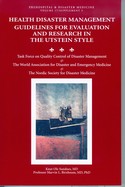Guidelines for Evaluation and Research
Health Disaster Management: Guidelines for Evaluation and Research introduces a structural framework for investigations into the medical and public health aspects of disasters including: a standardized, universal set of definitions; a conceptual model for disasters; indicators and standards; descriptions of 14 basic societal functions bound together by a coordination and control function; and a disaster response template and two research templates. The templates are to be used in the design, conduct, analysis, and reporting of research and/or evaluations of interventions directed at preventing hazards from becoming a disaster-producing event, mitigating the of such an event on the affected society, and/or responses to a disaster.

 |
Credits, Forward, & Preface | Page Number |
| I. Introduction | ||
| Chapter One: Introduction | 1 | |
| Chapter Two: Methods Used for Evaluation and Research | 25 | |
| II. Conceptual Framework | ||
| Chapter Three: Overview and Concepts | 31 | |
| Chapter Four: Conceptual Model: Hazard, Risk, Vulnerability, and Damage | 56 | |
| Chapter Five: Functions, Requirements, Supplies, Damage, and Needs | 69 | |
| Chapter Six: Interventions, Effects, Outcomes, Benefits, and Costs | 103 | |
| Chapter Seven: Responses, Relief, and Recovery | 113 | |
| Chapter Eight: Ethical Issues | 128 | |
| Glossary of Terminology | 144 |
This work was supported in part by grants from the Laerdal Foundation for Acute Medicine and the Royal Norwegian Ministry of Foreign Affairs.
Key Words: analysis catastrophe; data collection; definitions description of disaster; disaster; disaster management; disaster medicine disaster phases; disaster research; disaster responses; extrication; health consequences health status; injuries; interventions; measures of effectiveness; medical responses; morbidity; mortality; preparedness; needs assessment; public health; research; research design; research methods; risk evaluation; scope; template; type; Utstein style; warning

- Mediterranean Club for Burns and Fire Disasters
- Nordic Society of Disaster Medicine
- Nordic International Rescue Foundation
- Organization of African Unity
- Swedish National Board on Health and Welfare
- United Nations Department of Humanitarian Affairs and
- World Association for Disaster and Emergency Medicine

- Jacov Adler, United Nations Department of Peacekeeping Operations, Israel
- Marvin L. Birnbaum, MD, PhD, United States
- Professor Johan Calltorp, PhD, Sweden
- Professor S. William A. Gunn, MD, Switzerland
- Dr. O.J. Khatib, MD, Organization of African Unity
- Professor Michele Massellis, MD, Italy
- Ernesto A. Pretto, MD, MPH, United States
- Robert Souria, United Nations Department of Humanitarian Affairs, Switzerland
- Knut Ole Sundnes, MD, Norway, (Chairman)
- Takashi Ukai, MD, Japan
Other Participants
- Dr. Matti Matilla, Finland
- Karl-Axel Norberg, MD, Sweden
- Edmund Ricci, PhD, United States
- Margareta Rubin, Sweden